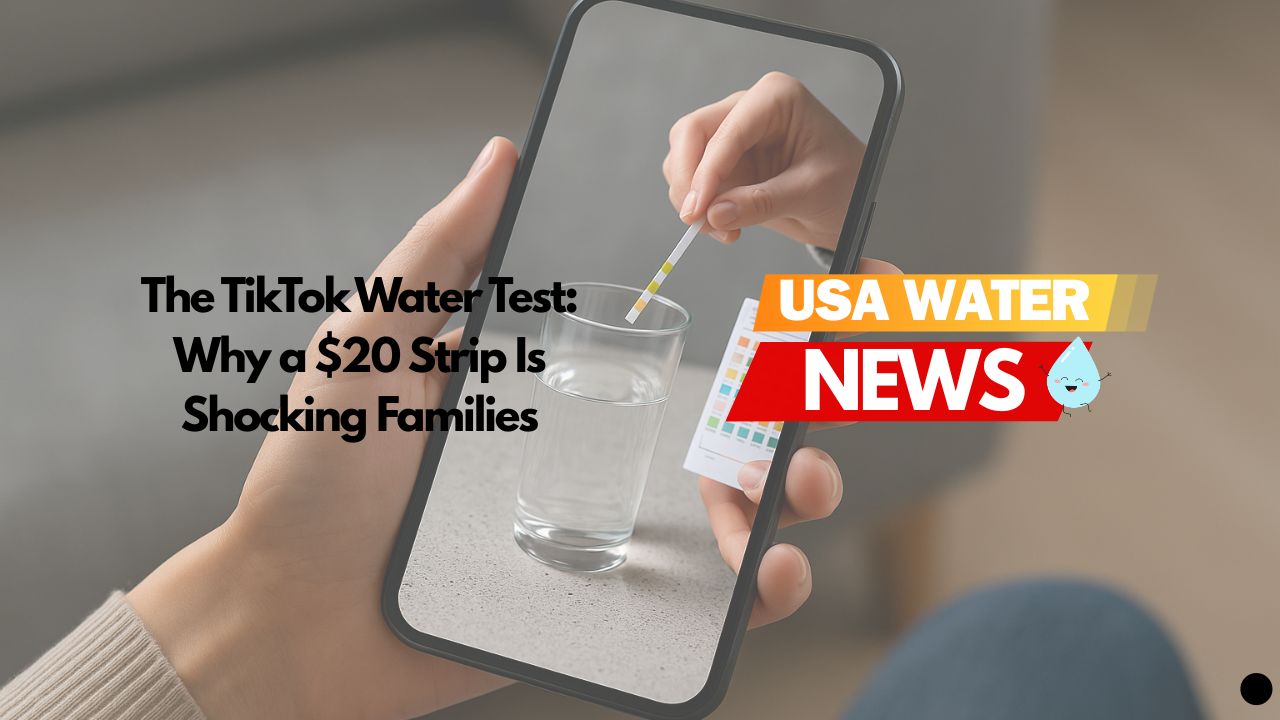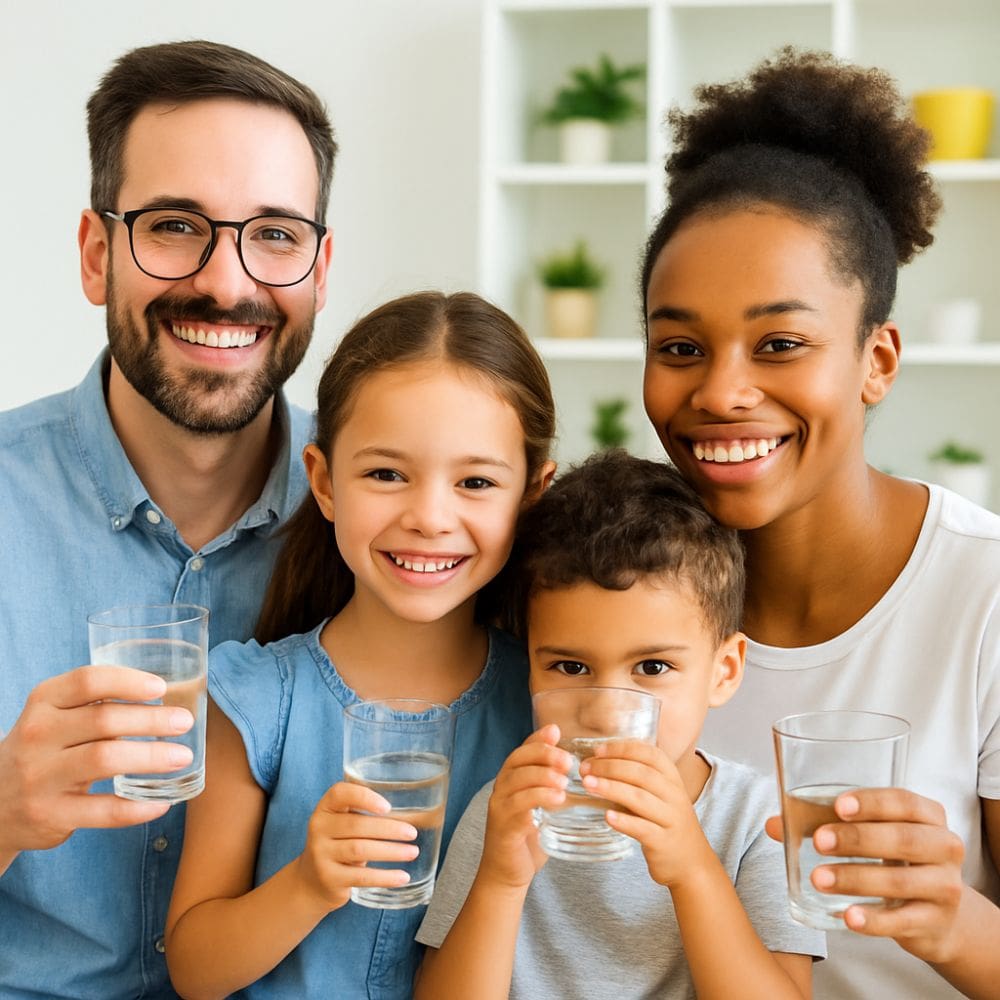A simple $20 test strip challenge is revealing compounds in homes where nobody expected them – and the results are going viral for all the wrong reasons.
If you’ve been on TikTok lately, you might have seen videos that start with someone holding up colorful test strips and end with them looking absolutely horrified at their tap water results.
The “Water Test Challenge” isn’t like those fun dance trends or recipe videos. This one is scaring people. And it’s spreading fast because families are learning that even clean-looking tap water can contain trace substances – often within safety limits – that aren’t always obvious.
It all started when a mom from Phoenix posted a video testing her apartment’s water with a basic test kit she bought online. She was just curious – her water tasted fine and looked clear. But when those test strips changed colors, her tap water revealed compounds she hadn’t expected — most of which are within legal safety limits, but still surprising to see.
“I literally thought these test kits were broken,” she said in a follow-up video that has now been viewed more than 2 million times. “There’s no way my water has all this stuff in it.”
How the Challenge Actually Works
The TikTok water test challenge is straightforward. People purchase water testing strips online (typically priced between $15–25) that check for common substances like chlorine, bacteria, lead, pesticides, and other chemicals.
You dip the strips in your tap water, wait a few minutes, and compare the colors to a chart. Each color represents a concentration level of a particular compound.
The surprising part isn’t necessarily the presence of substances – it’s that the results often show unexpected findings even in homes with clear, good-tasting water.
Users are sharing test results from:
- Brand new apartment buildings
- Suburban homes
- Schools and offices
- Restaurants and coffee shops
Why Everyone’s Getting Surprising Results
Water quality researchers say the TikTok test results aren’t necessarily wrong – people just aren’t used to seeing what’s normally present in treated water.
Experts from institutions like the University of Arizona explain that municipal water systems commonly add chlorine to kill bacteria, and trace levels of minerals or treatment chemicals may also be present. These are usually within regulated safety limits but can still register on at-home test kits.
The key issue is that “legal” and “zero” are not the same. Water suppliers are allowed to have certain levels of substances as long as they remain below EPA safety thresholds. But when consumers see any detection, they may assume something’s wrong.
The Results That Are Going Viral
Some of the most widely shared TikTok videos show:
- High chlorine levels – even in areas where water doesn’t have a noticeable smell.
- Bacteria detection – showing up despite recent city inspection reports.
- Heavy metals – including lead or copper, sometimes in homes with newer pipes.
- Unusual pH – indicating water that’s more acidic or basic than expected.
Many videos feature multiple strips changing colors, leading to genuine alarm from the creators.
What Water Providers Say
Across the U.S., municipal water departments have responded to increased public concern, issuing statements to remind residents that city water is tested frequently and must meet rigorous federal standards.
One Arizona water provider stated that their system is tested hundreds of times each month. They emphasized that just because a substance is detectable doesn’t mean it’s unsafe.
Still, utility officials admit that at-home test kits can sometimes catch things that standard city tests miss – especially when issues stem from the plumbing inside individual homes.
The Test Kit Boom
Companies selling home water testing kits have seen demand skyrocket. Some report sales increases of 400–500% since the TikTok trend began.
Basic test kits typically detect 10–15 substances and cost under $30. More advanced lab kits can cost up to $100, while professional home water assessments may run $500 or more.
However, not all test kits are equal. Accuracy can vary, and even reliable results may be misunderstood by those without technical knowledge.
The Pros and Cons of DIY Testing
DIY testing can help uncover:
- Lead from aging pipes
- Bacteria in stagnant plumbing
- Fluctuations between official city tests
- Localized contamination in home water systems
But they come with limitations:
- They don’t detect every contaminant
- Accuracy can be impacted by timing, user error, or temperature
- They can’t always distinguish between harmful and harmless levels
- They don’t identify the source of contamination
What Experts Recommend
Water quality scientists say increased public awareness is a positive step but caution against drawing conclusions based on test strips alone.
Finding chlorine, for example, might indicate that your city’s treatment process is working as intended. If results raise concerns, the best next step is to consult your local utility or get your water tested by a certified lab.
Why This Trend Matters
The TikTok water test challenge is creating a wave of awareness around drinking water safety.
For decades, most Americans haven’t given their tap water much thought – unless there was a crisis. These videos are changing that by making people curious, engaged, and sometimes alarmed about what’s in their water.
The Reality Check
Most U.S. municipal water supplies are considered safe under federal law. But your tap water’s final quality depends on a lot more than just the treatment plant – including the distribution system and your home plumbing.
That means even neighbors on the same block can receive different results.
What You Can Do
- Start small: Try a basic test kit to get a rough sense of your water’s profile.
- Understand results: Don’t panic at color changes. Research what they mean.
- Get professional testing: If something seems off, send a sample to a certified lab.
- Call your water utility: They can provide reports specific to your area.
- Know your source: Well water, city water, and private systems each have unique challenges.
The Takeaway
Tap water is generally safe, but “safe” doesn’t always mean “pure.” For households with infants, elderly residents, or health concerns, even minor contaminants might be worth looking into.
This trend is inspiring a new wave of consumers who are curious and cautious – and that could lead to smarter decisions about home water quality in the future.
Disclaimer This article is for general informational purposes only and does not constitute professional advice on water safety, health, or testing procedures. Results from home test kits may vary based on usage, accuracy, and environmental factors. If you are concerned about your water quality, please consult your local water utility or a certified testing lab. CleanAirAndWater.net does not make any guarantees regarding the accuracy or implications of home test kit results. a certified testing lab. CleanAirAndWater.net does not make any guarantees regarding the accuracy or implications of home test kit results.
Explore Local Water Reports
Want to see what’s in your city’s water? Browse the Clean Air and Water Directory for detailed breakdowns across the U.S.
Please read – our information
The information presented on cleanairandwater.net is compiled from official water quality reports, trusted news sources, government websites, and public health resources. While we strive for accuracy and thoroughness in our presentations, we are not scientists, engineers, or qualified water quality professionals.
Our mission is to present water quality information in an accessible, real-world format that helps people understand what’s in their water and make informed decisions about their health and safety. We believe that complex environmental information should be available to everyone in a format that’s easy to understand.
We make every effort to ensure our content is current and accurate, but we cannot guarantee that all information is complete or error-free. This website should not replace official communications from your local water utility or health department. We always recommend consulting official sources for the most up-to-date information regarding your specific water system.
Clean Air and Water is not liable for any unintentional errors, omissions, or outdated information. The content on this site is provided for informational purposes only and should not be considered professional advice.


